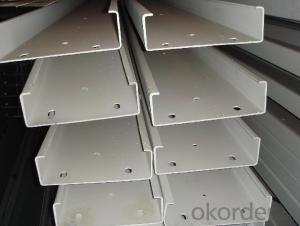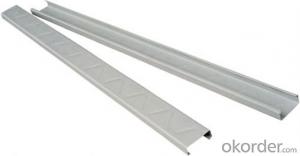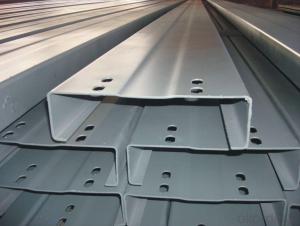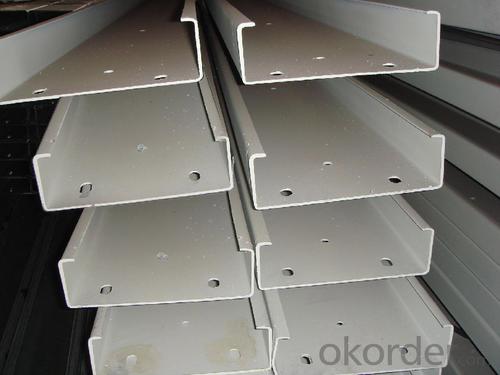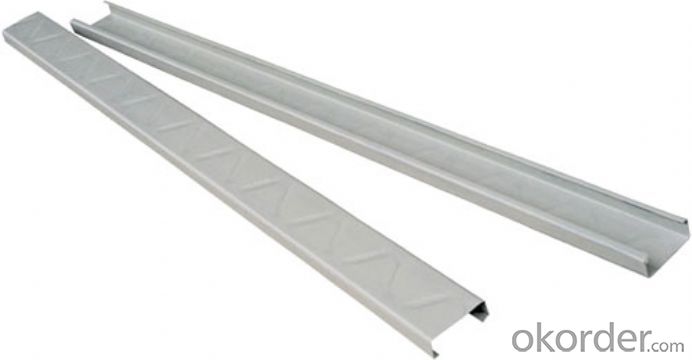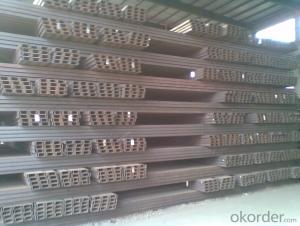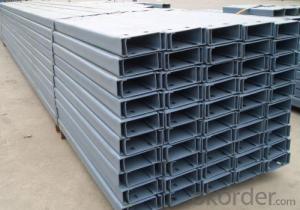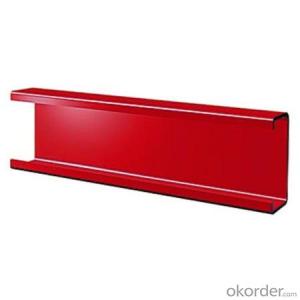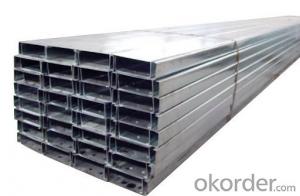Channel Steel Beam C Purlin Galvanized Steel C Channel
- Loading Port:
- Tianjin
- Payment Terms:
- TT or LC
- Min Order Qty:
- 27 m.t.
- Supply Capability:
- 24000 m.t./month
OKorder Service Pledge
OKorder Financial Service
You Might Also Like
Product Description:
OKorder is offering Channel Steel Beam C Purlin Galvanized Steel C Channel at great prices with worldwide shipping. Our supplier is a world-class manufacturer of steel, with our products utilized the world over. OKorder annually supplies products to European, North American and Asian markets. We provide quotations within 24 hours of receiving an inquiry and guarantee competitive prices.
Product Applications:
Channel Steel Beam C Purlin Galvanized Steel C Channel are ideal for structural applications and are widely used in the construction of buildings and bridges, and the manufacturing, petrochemical, and transportation industries.
Product Advantages:
OKorder's Channel Steel Beam C Purlin Galvanized Steel C Channel are durable, strong, and resist corrosion.
Main Product Features:
· Premium quality
· Prompt delivery & seaworthy packing (30 days after receiving deposit)
· Corrosion resistance
· Can be recycled and reused
· Mill test certification
· Professional Service
· Competitive pricing
Product Specifications:
1. Heat-resistant
2. Light weight
3. Easy for assembling
4. High Air Exhausting Efficiency
5. Low cost
Steel Beam C purlin Galvanized Steel C Channel
C&Z purlin is made by cold rollde strips and galvanized steels by roll forming.
| Efective width | 80mm-300mm |
| Length | According customer's request (less than 12m) |
| Materials | Galvanized steel. |
| Thickness | 1.6-3.0mm |
| Surface treatment | Zinc coated or Alu-zine coated. |
Usage
purlin and wall beam of steel structure building
The C-shaped purlins have excellent anti-bending property and are easy to install.
They are widely used as the supporter of roof and wall in large-scale and mid-scale construction,
such as factory, warehouse, garage, exhibition center, cinema, theatre, garden and so on.
Advantage:
(1). Design according to customers’ requirements
(2). Manufacture under complete quality control system---ISO9001:2008
(3). Installation with instruction of experienced engineers
(4). Easy to assemble and dismantle
(5). Eco-friendly material: can be used for several times and can be recycled
(6). Shorter construction period, longer using time
(7). High strength and stiffness, high weight bearing.
FAQ:
Q1: Why buy Materials & Equipment from OKorder.com?
A1: All products offered byOKorder.com are carefully selected from China's most reliable manufacturing enterprises. Through its ISO certifications, OKorder.com adheres to the highest standards and a commitment to supply chain safety and customer satisfaction.
Q2: How do we guarantee the quality of our products?
A2: We have established an advanced quality management system which conducts strict quality tests at every step, from raw materials to the final product. At the same time, we provide extensive follow-up service assurances as required.
Q3: How soon can we receive the product after purchase?
A3: Within three days of placing an order, we will begin production. The specific shipping date is dependent upon international and government factors, but is typically 7 to 10 workdays.


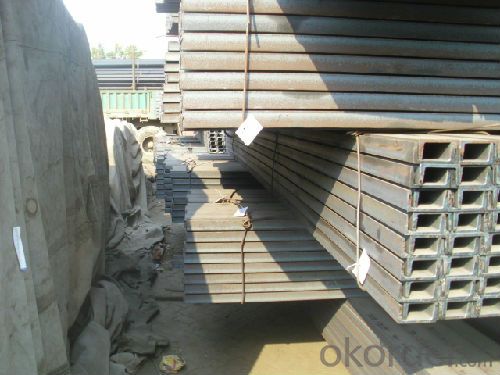
- Q: How do steel channels contribute to the overall safety of a structure?
- There are several ways in which steel channels contribute to the overall safety of a structure. To begin with, steel channels provide structural support and stability to the building. In the construction industry, they are commonly utilized as load-bearing members. This aids in the efficient and even distribution of the structure's weight. As a result, the building can withstand external forces like wind, earthquakes, and heavy loads without collapsing. The presence of steel channels creates a robust framework that enhances the building's overall safety and structural integrity. Moreover, steel channels play a critical role in fire safety. Steel is a non-combustible material, and when used as channels, it effectively prevents the spread of fire within the structure. In the event of a fire, steel channels act as fire barriers, limiting the movement of flames and heat to specific areas. This containment of fire helps minimize damage and provides occupants with more time to evacuate safely. Furthermore, steel channels exhibit exceptional resistance to corrosion and deterioration, making them highly durable and reliable. Unlike other materials, steel does not decay, distort, or degrade over time. This longevity ensures that the structure remains stable and secure in the long term, reducing the risk of accidents and structural failures. Additionally, steel channels are frequently utilized in the construction of seismic-resistant structures. Their impressive strength and flexibility allow them to absorb and dissipate seismic energy during earthquakes. This ability to withstand seismic forces helps to minimize structural damage and ensures the safety of the building's occupants. In conclusion, steel channels contribute significantly to the overall safety of a structure by providing structural support, fire resistance, durability, and seismic resistance. Their inclusion in construction enhances the stability, strength, and integrity of the building, guaranteeing the safety and well-being of its occupants.
- Q: When building a high building, in order to take scaffolding, the channel into the wall, support scaffolding, etc., after the completion of scaffolding dismantled, channel after taking out, although the hole will be filled well, but the building will not leak it? The building I bought a total of 32 layers, wherein the 9 layer, 17 layer, 25 layer into the channel, I bought 17 layers, the future will Water Leakage ah, good fear, a knowledgeable friend to help answer,...
- The facade is usually not waterproof, because it does not soak in water.
- Q: What are the different methods for reinforcing steel channels?
- Some of the different methods for reinforcing steel channels include using additional steel bars or rods, adding concrete to the channel, using fiber-reinforced polymers (FRP), or applying carbon fiber wraps. These methods help to enhance the strength and durability of the steel channels, making them more resistant to bending, cracking, or other structural issues.
- Q: How do steel channels contribute to acoustic performance?
- Steel channels can play a significant role in improving acoustic performance in various applications. One of the key contributions of steel channels to acoustic performance is their ability to minimize sound transmission and improve sound insulation. Steel channels are often used as part of wall or ceiling systems in buildings to create a barrier that prevents sound from traveling between different spaces. The design and construction of steel channels allow for the installation of sound insulation materials such as mineral wool or acoustic foam. These materials help to absorb and dampen sound waves, reducing the transmission of noise from one area to another. By incorporating steel channels in the construction of walls or ceilings, the overall acoustic performance of a space can be greatly enhanced. In addition to their sound insulation properties, steel channels can also contribute to the improvement of room acoustics. By using steel channels to create a suspended ceiling, for example, it is possible to create a more balanced and controlled sound environment. The space between the steel channels can be filled with acoustic tiles or panels, which can absorb sound reflections and reduce echoes, resulting in better speech intelligibility and overall sound quality. Moreover, steel channels can also be used to support the installation of sound-absorbing materials on walls or ceilings. These materials, such as fabric-wrapped panels or perforated metal sheets, can help to reduce reverberation and echo in a room, improving its acoustic performance. Steel channels provide a sturdy framework to securely mount these materials, ensuring their effectiveness in enhancing sound absorption. Overall, steel channels contribute to acoustic performance by reducing sound transmission, improving sound insulation, and enhancing room acoustics. Whether used in the construction of walls, ceilings, or as a support for sound-absorbing materials, steel channels play a vital role in creating a more acoustically favorable environment, whether it be in residential, commercial, or industrial settings.
- Q: Can steel channels be used for structural support?
- Yes, steel channels can be used for structural support. Steel channels are commonly used in construction as they provide strength and durability. They are often used in buildings, bridges, and other structures to provide support and stability. Steel channels are designed to distribute the weight and load evenly, making them ideal for structural support. Additionally, they are versatile and can be easily customized to meet specific design requirements. Overall, steel channels are a reliable and effective choice for providing structural support in various construction projects.
- Q: What are the disadvantages of using steel channels?
- There are a few disadvantages of using steel channels in certain applications. Firstly, steel channels tend to be heavy and bulky, which can make them difficult to handle and transport. This can add to the overall cost and complexity of a project. Additionally, steel channels are prone to corrosion and rusting, especially when exposed to moisture or harsh environmental conditions. This can lead to a decrease in structural integrity and a shorter lifespan for the channels. Regular maintenance and protective coatings may be required to mitigate this issue. Another disadvantage is that steel channels have limited versatility in terms of shape and size. They are typically available in standard shapes and sizes, which may not always be suitable for specific design requirements. Customization options can be limited and may come with additional costs. Furthermore, steel channels can be relatively expensive compared to other materials, especially if they are made from high-quality steel alloys. This can make steel channels less cost-effective for certain projects, especially when there are alternative materials that can fulfill the same purpose at a lower cost. Lastly, steel channels are poor insulators of heat and electricity. In applications where thermal or electrical conductivity is a concern, alternative materials may be more suitable. Overall, while steel channels offer many advantages such as strength and durability, it is important to consider these disadvantages before deciding to use them in a particular application.
- Q: What standard is channel steel 250*90*9?
- Channel steel: the channel steel is a long strip steel with a cross section. Its specification means: such as 120*53*5, which means that the waist height is 120 millimeters, the width of the leg is 53 millimeters of channel, the waist is 5 mm thick channel, or called 12# channel steel. The same height of the channel, if there are several different leg width and waist thickness, also need to add a, B, C on the right side of the model to distinguish, such as 25a#, 25b#, 25c# and so on.
- Q: What are the different load distribution methods for steel channels?
- There are several load distribution methods for steel channels, which are commonly used in various construction and engineering applications. These methods aim to evenly distribute load and maximize the structural integrity and strength of the channels. 1. Concentrated Load Distribution: This method involves placing the load on specific points along the steel channel. It is commonly used when there are specific areas or points that require more load-bearing capacity. 2. Uniform Load Distribution: In this method, the load is distributed uniformly along the entire length of the steel channel. It is often used when the load is evenly distributed or when there is no specific point requiring more load-bearing capacity. 3. Partial Load Distribution: This method involves distributing the load partially along the steel channel, focusing on specific sections or areas that require more strength. It is commonly used when there are varying load requirements along the length of the channel. 4. Cantilever Load Distribution: This method applies to steel channels that are fixed at one end and have the load placed at the free end. It is commonly used in structures such as bridges and balconies. 5. Distributed Load Distribution: This method involves dividing the load into smaller segments and distributing them along the length of the steel channel. It is commonly used when the load is not uniformly distributed or when there are varying load requirements at different points. 6. Point Load Distribution: In this method, the load is concentrated at specific points along the steel channel. It is commonly used when there are specific points that require more load-bearing capacity. It is important to note that the selection of the appropriate load distribution method depends on factors such as the type of structure, intended application, load requirements, and engineering specifications. It is crucial to consult with a structural engineer or design professional to determine the most suitable load distribution method for a specific steel channel application.
- Q: Channel 18, number 18. What does it mean?
- The theoretical weight of 19.752 kg per metre, channel 18#a specifications 180X, 68x 7 mm, theoretical weight of 20.174 kg per meter, channel 18#b specifications 180 X70 x9mm, theoretical weight of 23 kg per meter, specifications are x height, X leg width, waist thickness.
- Q: What are the different types of steel channel accessories?
- Various industries and construction projects commonly utilize different types of steel channel accessories. Some of the most frequently used options include: 1. Brackets: These accessories offer additional support and stability to the structure by securing steel channels in place, preventing any movement or sagging. 2. Connectors: Used to join multiple steel channels together, connectors come in various designs, such as corner or straight connectors, ensuring a strong and secure connection. 3. End caps: These cover the exposed ends of steel channels, providing a polished appearance while also protecting against damage or corrosion. 4. Mounting hardware: This category encompasses bolts, screws, and brackets that attach steel channels to walls, floors, or other surfaces, guaranteeing a secure installation. 5. Clips and clamps: These accessories secure cables, pipes, or other equipment to steel channels, offering a reliable and organized solution for managing and securing various components. 6. Hangers: Used to suspend or hang equipment, pipes, or cables from steel channels, hangers are commonly employed in HVAC systems, electrical installations, and plumbing applications to provide support and prevent sagging. 7. Slotted channels: Specifically designed with slots or holes along the length, these channels allow for easy and adjustable mounting of accessories like brackets, clamps, or hangers without requiring additional drilling or modifications. Overall, steel channel accessories play a vital role in enhancing the functionality, stability, and appearance of steel channel structures across a wide range of applications.
Send your message to us
Channel Steel Beam C Purlin Galvanized Steel C Channel
- Loading Port:
- Tianjin
- Payment Terms:
- TT or LC
- Min Order Qty:
- 27 m.t.
- Supply Capability:
- 24000 m.t./month
OKorder Service Pledge
OKorder Financial Service
Similar products
Hot products
Hot Searches
Related keywords
